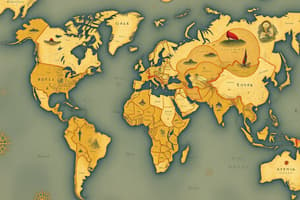Podcast
Questions and Answers
What percentage of Earth's surface do continents cover?
What percentage of Earth's surface do continents cover?
- About 15%
- About 50%
- About 40%
- About 29% (correct)
Which continent is the largest?
Which continent is the largest?
- Antarctica
- North America
- Asia (correct)
- Africa
What are landforms?
What are landforms?
- Artificial landmarks
- Natural features of Earth's surface (correct)
- Underwater formations
- Man-made structures
How many continents are commonly recognized?
How many continents are commonly recognized?
Where is most of the world's land area located?
Where is most of the world's land area located?
What are the main political and cultural units on Earth?
What are the main political and cultural units on Earth?
What is the defining characteristic of mountains?
What is the defining characteristic of mountains?
Which landform is described as having flat, elevated land often covered in vegetation?
Which landform is described as having flat, elevated land often covered in vegetation?
What is the defining characteristic of tropical climate?
What is the defining characteristic of tropical climate?
Which climate type is known for regions with low rainfall and high temperatures?
Which climate type is known for regions with low rainfall and high temperatures?
What does geography classify areas according to?
What does geography classify areas according to?
How does studying continents and countries contribute to understanding the world?
How does studying continents and countries contribute to understanding the world?
Flashcards are hidden until you start studying
Study Notes
Geography for Kids: Exploring the World's Landscape
Geography is a fascinating subject that helps us understand the world around us. It teaches us about continents, countries, landforms, and climate. In this article, we will explore these topics and more, designed especially for young readers.
Continents
Continents are the large masses of land that stand above the level of the sea, covering about 29% of Earth's surface. There are five commonly recognized continents:
- Asia
- Africa
- North America
- South America
- Antarctica
- Europe
- Australia
These continents are distributed unevenly over Earth's surface, with more than two-thirds of all land area located in the Northern Hemisphere. Asia is the largest continent, while Australia is the smallest.
Countries
Countries are the main political and cultural units on Earth, each with its own unique flag and name. There are numerous countries around the world, and each has its own distinct culture, history, and geography. Some countries are located on the same continent, while others span multiple continents.
Landforms
Landforms are the natural features of Earth's surface, such as mountains, hills, plateaus, and plains. They play a crucial role in shaping the world's landscape and can vary greatly across different continents. Some examples of landforms include:
- Mountains: Tall, steep terrain, often capped with snow and ice.
- Hills: Moderately steep, irregular terrain.
- Plateaus: Flat, elevated land, often covered in vegetation.
- Plains: Flat, vast areas of land with slight elevation changes.
Climate
Climate refers to the average weather conditions in a specific area over a period of time. It is influenced by factors such as temperature, precipitation, wind, and sunshine. Geography is concerned with the classification of areas according to climate, as different areas have different climatic conditions. Some examples of climate types include:
- Tropical: Regions with heavy rainfall and average temperatures above 80°F (27°C) throughout the year.
- Desert: Regions with low rainfall and high temperatures.
- Polar: Regions with cold temperatures and a short growing season.
- Mediterranean: Regions with mild, humid summers and cool, wet winters.
Conclusion
Geography is a fascinating subject that helps us understand the world around us. By studying continents, countries, landforms, and climate, we can gain a deeper appreciation for the diverse and amazing planet we live on.
Studying That Suits You
Use AI to generate personalized quizzes and flashcards to suit your learning preferences.




